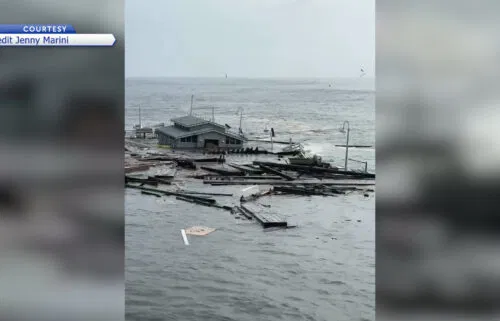Sailor acquitted of setting fire that destroyed massive ship
By ELLIOT SPAGAT
Associated Press
SAN DIEGO (AP) — A military judge on Friday acquitted a sailor of arson in a fire that destroyed the USS Bonhomme Richard, a blow to the Navy as it faces allegations of improper training and maintenance of the $1.2 billion amphibious assault ship.
Ryan Sawyer Mays, 21, deeply exhaled when the verdict was read, put both hands on the defense table, broke into sobs and hugged supporters in the audience at Naval Base San Diego.
Outside the courtroom building, Mays read a brief statement to reporters and declined to answer questions. He did not address his plans.
“I can say that the past two years have been the hardest two years of my entire life as a young man,” he said. “I’ve lost time with friends. I’ve lost friends. I’ve lost time with family, and my entire Navy career was ruined. I am looking forward to starting over.”
Prosecutors presented no physical evidence during the nine-day trial that the sailor set the ship on fire, while the defense chipped away at the credibility of a key witness, Seaman Kenji Velasco, who changed his account over time.
Gary Barthel, a former Marine judge advocate who represented Mays at a preliminary hearing, said undercutting Velasco’s credibility was key. Barthel has said the judge in the preliminary hearing recommended against a court martial, but Vice Adm. Steve Koehler, former commander of the San Diego-based U.S. 3rd Fleet, had the final say.
The ship’s lower vehicle storage area “became a junkyard and I believe throughout this entire process the Navy was attempting to clean up their mess by accusing Seaman Mays of these allegations,” Barthel told reporters.
Prosecutors did not comment after the verdict. The Navy said through a spokesman, Lt. Samuel R. Boyle, that it “is committed to upholding the principles of due process and a fair trial.”
Prosecutors said Mays was angry and vengeful about failing to become a Navy SEAL and being assigned to deck duty, prompting him to ignite cardboard boxes on July 12, 2020 in the lower vehicle storage area on the vessel, which was docked in San Diego while undergoing $250 million in maintenance work. They said he wanted to drive home his text earlier to his division officer that the ship was so cluttered with contractors’ material it was “hazardous as (expletive).”
The prosecutor, Capt. Jason Jones, acknowledged in court a Navy report last year that concluded that the inferno was preventable and unacceptable, and that there were lapses in training, coordination, communications, fire preparedness, equipment maintenance and overall command and control. The failure to extinguish or contain the fire led to temperatures exceeding 1,200 degrees (649 Celsius) in some areas, melting sections of the ship into molten metal that flowed into other parts of the ship. Navy leaders disciplined more than 20 senior officers and sailors.
Jones told the judge there is no doubt the Navy “loses the ship” that morning, but Mays is to blame for igniting it.
“That sucker punch from behind, that’s what the Navy could have never prevented,” he said.
Mays thought he would be jumping out of helicopters on missions with the SEALs, but instead he was chipping paint on the deck of a ship, and he hated the Navy for that, Jones said.
“When on deck, you are about as far away from the SEALs as you are ever going to be,” Jones said.
Defense lawyers said the trial only exposed a shoddy probe by government investigators who rushed to judgment and failed to collect evidence showing that the culprit also could have been lithium ion batteries or a sparking forklift.



